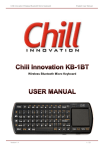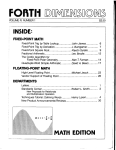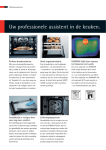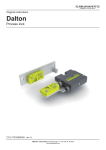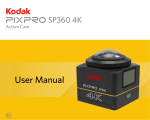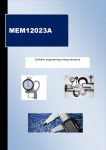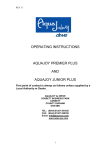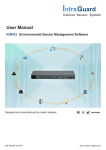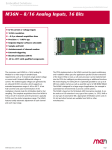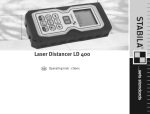Download LASER DISTANCE METER 200 FT.
Transcript
LASER DISTANCE METER
200 FT. (60m)
USER’S MANUAL
LDM60
Please read this manual carefully and thoroughly before using this product.
TABLE OF CONTENTS
Introduction . . . . . . . . . . . . . . . . . . . . . . . . . . . . . 3 – 5
Key Features . . . . . . . . . . . . . . . . . . . . . . . . . . . . . . . . 6
What’s in the Box . . . . . . . . . . . . . . . . . . . . . . . . . . . . 6
Product Overview . . . . . . . . . . . . . . . . . . . . . . . . . 7 – 9
Safety Instructions . . . . . . . . . . . . . . . . . . . . . . . . . . 10
Setup Instructions . . . . . . . . . . . . . . . . . . . . . . . . . . 10
Install Batteries . . . . . . . . . . . . . . . . . . . . . . . . . 10
Operating Instructions . . . . . . . . . . . . . . . . . . . 10 – 25
Powering On and Off . . . . . . . . . . . . . . . . . 10 – 11
Quick Start Instructions . . . . . . . . . . . . . . . . . . 11
Choosing a Measurement Reference . . . . . . . . 12
Clearing the Display/Cancelling an Action . . . . 13
Changing the Measurement Unit . . . . . . . . . . . 13
Turning the Backlight On and Off . . . . . . . . . . . 13
Measuring Distances . . . . . . . . . . . . . . . . 14 – 22
Direct Measurements . . . . . . . . . . . . . 14 – 15
Continuous Distance Measurement
(Distance Tracking) . . . . . . . . . . . . . 15 – 16
Adding and Subtracting Distances . . . 17 – 18
Indirect Measurements of Height
or Length using Triangulation . . . . . 18 – 22
Measuring Areas . . . . . . . . . . . . . . . . . . . . 22 – 23
Measuring Volumes . . . . . . . . . . . . . . . . . 23 – 24
Recalling and Clearing Stored
Measurements/Calculations . . . . . 24 – 25
Specifications . . . . . . . . . . . . . . . . . . . . . . . . . . . . . . 26
Operating & Maintenance Tips . . . . . . . . . . . . 27 – 28
Warranty Information . . . . . . . . . . . . . . . . . . . . . . . . 29
Return for Repair Policy . . . . . . . . . . . . . . . . . . . . . . 30
2
INTRODUCTION
Thank you for purchasing General Tools & Instruments’
(General’s) LDM60 Laser Distance Meter-200 ft. (60m). Please
read this user’s manual carefully and thoroughly before using the
instrument.
The LDM60 is designed to replace a tape measure for
professionals such as builders, architects, engineers, surveyors,
carpenters, plumbers, painters, electricians, realtors, home
inspectors, HVAC system designers and installers, and
carpet/flooring installers and salesmen. The meter works by
projecting a red laser beam on a target and measuring how long
it takes the reflected beam to return to the meter. This time is
proportional to the distance to the target. The LDM60’s range of
approximately 200 ft. (60m) makes it suitable for most indoor
measuring tasks and many outdoor jobs as well.
Why is the LDM60 better than a tape measure?
• It’s faster. It takes much less time to hold the meter against a
wall, aim at the opposite wall and press the measurement
button than to secure one end of a tape measure, walk the
other end to the far wall, write down the reading and retract
the tape. The longer the distance to be measured, the more
time saved. That’s true for small rooms, and even more so for
larger spaces. The more crowded the area to be measured—
whether with furniture, equipment or trees—the greater the
time savings. The average measuring job can be completed in
about 1/3 the time needed to use a tape measure. In addition
to this time savings, there’s also a savings in labor costs; many
jobs that require two people holding the ends of a tape
measure can be done with one person holding a laser distance
meter.
3
• It’s more accurate. Thanks to precision optics, laser devices
like the LDM60 can measure the distance between any two
points with ±1/16 in. (±1.5mm) accuracy. It’s impossible to get
that level of precision from a tape measure that is prone to
bending and sagging. What’s more, it’s much easier to read the
LDM60’s digital display, which can be held at eye level, than to
read a tape measure that needs to be held in a measuring
position that makes reading tiny hash marks difficult. In
addition, like most laser distance meters the LDM60 lets the
user choose his measurement unit. This eliminates the need to
convert measurements from one unit to another, a common
source of measurement error. Finally, the LDM60 automatically
memorizes the last 20 measurements it makes. This eliminates
the need to write down readings as you make them, another
convenience.
• It’s smarter. The LDM60 has some front-panel buttons that
you won’t find on any tape measure. Push the
Area/Volume
button once, and the meter prompts you to make the length
and width measurements needed to calculate the size of an
area—and then does the math for you. Push the button twice,
and the meter prompts you to make height, length and width
measurements—and then multiplies the three values to
calculate the volume of interest. High-end laser distance
meters’ ability to calculate areas and volumes has made them
favorites with carpet/flooring and HVAC professionals,
respectively.
• It’s more versatile. Another button on the front panel of
the LDM60 makes it possible to make measurements that
no tape measure can make. This button activates Indirect
Measurement mode. In this mode the meter uses Pythagorean
geometry to measure a distance based on its relationship to
other distances around it. In practical terms, what this means
4
is that the LDM60 can use triangulation to measure the height
of a tree or a building without anyone needing to climb it, or
the width of a river without anyone needing to cross it.
• It’s safer. Because the LDM60 can measure distance from a
distance, it takes the risk out of routine but tricky tasks. It’s no
longer necessary to stand on a stepladder and reach to
measure the height of a ceiling, or to climb a steep and
slippery incline to gauge the length of a pipe run.
The LDM60 has a 4-line backlit liquid-crystal display measuring
1 (W) x 1.44 (H) in. The meter comes in a box along with two
“AAA” batteries, a soft carrying case with a belt loop (holster),
a small Phillips-head screwdriver and this user’s manual.
KEY FEATURES
• 196.7 ft. (60m) range • Accuracy of ±1/16 in. (±1.5mm)
• Displays distances in feet + fractional inches (default), feet
with decimal fraction, inches or meters
• Calculates areas and volumes
• Uses triangulation to calculate height or length from a distance
• Backlit 4-line LCD
• Addition, subtraction, and continuous measurement (tracking)
modes ideal for layout work
• Fast response time
• Stores/recalls 20 measurements/calculations
• References measurements from meter’s front or rear edge
• Auto power off, auto laser off and auto backlight off
• Splashproof and dustproof to IP54 standard
• Pocket-sized and lightweight
• Powered by two “AAA” Alkaline batteries
5
WHAT’S IN THE BOX
The LDM60 comes in a box along with:
• A holster (soft pouch with a belt loop)
• Two “AAA” Alkaline batteries
• A small Phillips-head screwdriver for opening the
battery compartment
• This user’s manual
PRODUCT OVERVIEW
Fig. 1 shows all of the controls on the meter’s front panel. Fig. 2
shows all possible display icons and indications. Familiarize
yourself with the positions and functions of these controls and
indicators before moving on to the safety, setup and operating
instructions.
Fig. 1. The LDM60’s front-panel controls
1. Measurement button (activates laser)
2. Enters Area/Volume Measurement mode
3. Enters Indirect Distance Measurement mode
4. Enters Continuous Distance Measurement (Tracking) mode
5. Adds next measurement to previous one
6. Subtracts next measurement from previous one
7. Enters Memory Recall mode
8. Toggles measurement reference between meter’s front
and rear
6
MEAS
11
33
22
44
55
66
77
88
99
10
Fig. 1
9. Dual function button:
Chooses any of four distance units
Turns display backlight on and off
10. Triple function button: Powers meters off
Clears last measurement or cancels
last action
Clears (resets to zero) stored
measurement/calculation values one
at a time, starting with the oldest
value
7
Fig. 2. The LDM60’s display indications and icons
1. Measurements referenced from front edge of meter
2. Flashes when laser is on
3. Measurements referenced from rear edge of meter
4. Operating in Direct or Continuous Measurement Mode
5. Operating error indication
6–10. Measurement type indicator
Distance (direct)
Distance (indirect—triangulation with two inputs)
Distance (indirect—triangulation with three inputs)
Area
Volume
11. Battery status
12. No. of stored value displayed
13. Top display line
14. Value displayed on second line is a minimum
15. Second display line
16. Value displayed on third line is a maximum
17. Third display line
18. Bottom (summary) display line (shows last
measurement or calculation result)
8
11 12
12
11 11
2
2
28
3
3
4
4
5
5
6,7,8,9,10
6,7,8,9,10
➤
{
u
{
{
{
{
13
13
14
14
15
15
16
16
17
17
18
18
Fig. 2
9
SAFETY INSTRUCTIONS
CAUTION!
The meter’s targeting laser is a Class 2M type that emits less
than 1 mW of radiation at 660 nanometers.
Avoid direct eye contact with the laser, and do not point it at
people or animals. Eye protection is normally afforded by the
blink reflex. U.S. law prohibits pointing a laser beam at aircraft;
doing so is punishable by a fine of up to $10,000 and
imprisonment.
SETUP INSTRUCTIONS
INSTALL BATTERIES
The LDM60 is ready to use after you install the two supplied
“AAA” batteries in a compartment in the back of the meter. To
open the compartment, use the small supplied Phillips-head
screwdriver to loosen the single screw holding the battery
compartment cover in place. Remove the cover and set it aside.
Position the batteries so their polarity marks match the diagram
inside the compartment. Replace the cover and tighten the screw
to secure it.
OPERATING INSTRUCTIONS
POWERING ON AND OFF
To turn the meter on, press and release the MEAS button. This
activates the display and the laser. It also sounds a short beep,
causes the laser icon (Callout 2 of Fig. 2) to flash, and places the
meter in direct distance measurement mode.
10
While the meter is powered on, any push of any button produces
a beep to confirm that some action has taken place (a
measurement was made, an operating mode or measurement
unit was changed, etc.). The only actions that are not
accompanied by a beep are the laser timing out (after 30
seconds of inactivity) for safety reasons and the backlight timing
out (after 1 minute of inactivity) to conserve battery charge. The
beeper also sounds when the meter automatically powers off
after 3 minutes of inactivity. The beeper cannot be disabled.
To turn the meter off manually, press and hold the button.
The instrument will respond with a long beep as it powers off.
QUICK START INSTRUCTIONS
To make a quick distance measurement:
1. Power the meter on.
2. Within 30 seconds, point the top of the meter at a target and
press the MEAS button. The distance to the target—in the default
measurement unit of feet + fractional inches—will be
displayed on the bottom line of the display.
To temporarily change the distance measurement unit, follow the
instructions on p. 13.
If the laser has timed out (i.e., it has been on for more than
30 seconds), or if you have just made a measurement, you will
not see a red dot on the target and there will be no flashing icon
(Callout 2 of Fig. 2) on the display. To make a distance
measurement with the laser off, you must press the MEAS
button twice—once to activate the laser and once to make the
measurement. See pp. 27 and 28 for additional operating tips.
11
CHOOSING A MEASUREMENT REFERENCE
The LDM60 can reference its measurements from the front edge
of the meter or the rear edge.
For most distance measurements, choosing the rear edge as the
reference produces more-accurate readings. Doing so allows you
to hold the bottom of the meter horizontally against one wall of a
room, or vertically against the floor, and send the laser beam out
the top of the unit toward the opposite wall or the ceiling.
However, for continuous distance (tracking) measurements (see
p. 15), using the front of the meter as the reference produces
more-accurate readings. In tracking mode, you typically walk the
meter back from a wall to a distance specified on a blueprint. In
this case, what you want to measure is the distance to the wall
from the top of the meter.
The button on the front panel lets you select the front or the
rear edge of the meter as the measurement reference. The two
small icons shown in Fig. 3 are the corresponding display
indications.
When the meter is powered off and on again, the measurement
reference automatically resets to the default: the rear of the
meter.
Fig. 3. Referencing
measurements
from the rear (left)
and front (right)
of the meter
12
CLEARING THE DISPLAY/CANCELLING
AN ACTION
When pressed briefly, the triple-function button:
1. Works like the “Clear Entry” button on a calculator to
clear the last value entered in a calculation sequence
2. Works like the “Undo” command on a computer menu
to cancel the last action selected
3. Works like a “Reset” button to “zero-out” individual
measurement/calculation values stored in memory
(see pp. 24 and 25) in chronological order, oldest first
CHANGING THE MEASUREMENT UNIT
The LDM60’s default distance measurement unit is feet +
fractional inches, expressed as X’Y’’. The default area
measurement unit is square feet, expressed as ft2. The default
volume measurement unit is cubic feet, expressed as ft3.
To temporarily change the distance measurement unit,
press and hold the
button as many times as necessary until
the desired unit appears at lower right. The options, in order, are:
meters (m), feet (ft, expressed as a whole number plus a decimal
fraction), inches (in) and ft + in (expressed as X'Y", where X is a
whole number and Y is a whole number plus a common fraction).
When the meter is powered off and on again, the distance
measurement unit automatically resets to the default: feet +
fractional inches.
TURNING THE BACKLIGHT ON AND OFF
To turn the display backlight on, press the
button briefly.
The backlight will remain on for 1 minute and then automatically
turn off (without sounding a beep) to conserve battery charge.
To turn the backlight off, press the
button briefly again. The
default state is backlight off.
13
MEASURING DISTANCES
Direct Measurements
To measure the distance to a target:
1. Power on the meter and select a measurement unit, an
appropriate measurement reference (in most cases, the rear of
the meter) and an appropriate backlight state (on for indoor
work, off for outdoor work).
2. If the laser icon (Callout 2 of Fig. 2) is not flashing and the
laser pointer is not visible, press the MEAS button to activate the
laser. Doing so will sound a short beep, cause the laser icon to
flash, and place the meter in direct distance measurement
mode.
3. After checking that the laser is on, aim it at a target and press
the MEAS button. The distance to the target—in the default
distance unit of feet + fractional inches—will be displayed on
the bottom line of the display. The laser will flash quickly three
times, a short beep will sound, and the distance to the
target—in the default distance unit of feet + fractional
inches—will appear on the bottom line of the display in the
selected measurement unit.
To temporarily change the distance measurement unit, follow the
instructions on p. 13. Figure 4 is a screen shot of a measurement
of 5 feet, 1 and 15/16 inches.
14
Fig. 4. A direct distance
measurement of 5 feet,
1 and 15/16 inches
In direct distance measurement mode,
you can display up to four consecutive
15/16
measurements in the order in which they
were made. Fig. 5 is a screen shot which
shows the values of four direct distance
measurements made in top-to-bottom order.
Fig. 5. Four direct distance
7/8
measurements made in
3/4
order from top to bottom
Continuous Distance Measurement
1/8
(Distance Tracking)
13/16
This operating mode is ideal for
transferring measurements from
construction plans or blueprints. In practice,
you walk the meter back from a wall a specified distance while
the meter tracks its own position by measuring the distance to
the wall twice per second. As you make these dynamic
measurements and you close in on the specified distance, the
meter takes note of the closest and farthest you have been from
the wall and displays these minimum and maximum distances
along with the final distance.
Before entering continuous distance measurement mode, be
sure to temporarily change the measurement reference from the
rear of the meter to the front (see p. 12). Next, hold the meter
horizontally with its top against the wall shown on a plan. Then,
after making sure that the laser is on, press the
button and
back away from the wall while continuing to point the laser at
➤
5’01”
➤
21 08
3 03
113 04
53 03
15
the wall. The ➤ icon will appear on the display and the meter
will sound two beeps and begin to measure the distance from
the meter to the wall twice per second. Each measurement will
cause the beeper to sound, and the measurements will be shown
and continuously updated on the bottom line of the display. At the
same time, the second and third display lines continuously
update the meter’s minimum and maximum distance from the
wall during this measurement session.
When you and the meter stop moving, the meter assumes that
the specified distance has been reached and responds by
sounding multiple beeps. The inactivity triggers the 30-second
countdown to laser power off and the 3-minute countdown to
meter power off. The meter’s MIN, MAX and current distance
from the wall values remain on the display (Fig. 6) until the meter
automatically powers off automatically.
Fig. 6. The results of using
continuous measurement
to step off a specified
distance (10m) from a wall
To exit continuous distance
measurement mode, press the MEAS
button. This returns the meter to direct
distance measurement mode.
16
➤
u
0.112
11.33
10.000
Adding and Subtracting Distances
The LDM60 has two front-panel buttons that make it easy to
add or subtract a distance measurement from an existing
measurement, in effect turning the earlier measurement into a
baseline. This addition/subtraction function comes in handy
when accumulating multiple distance measurements.
For example, consider how the meter could speed up the
measurements involved in laying out a long brick wall of multiple
sections that are not in a straight line. Once stakes, strings and
frame are in place, the LDM60 could accurately measure the
length of each section by shooting from one stake to the next.
The meter would also keep a running total of these
measurements and display the final result—the wall’s
perimeter—on its bottom line.
To add a measurement to an existing measurement displayed
on the bottom line, press the
button. The earlier
measurement will be moved from the bottom line to the second
line and a flashing
icon will appear at the left of five dashes
(representing the distance value to be added) on the third line.
Then press the MEAS button while aiming the laser at the point
from which the first measurement was made. The meter will
measure the distance to that point, replace the dashes on the
third line with that value, and display the sum of the two
measurements on the bottom line (Fig. 7).
17
Fig. 7. A display showing the addition
of a 16.325 ft. measurement to
a measurement of 2.090 feet
➤
2.090
16.325
To subtract a measurement from an
existing measurement displayed on the
bottom line, press the
button. The
earlier measurement will be moved from the bottom line to the
second line and a flashing
icon will appear at the left of five
dashes (representing the distance value to be subtracted) on the
third line. Then press the MEAS button while aiming the laser at the
point from which the first measurement was made. The meter
will measure the distance to that point, replace the dashes on
the third line with that value, and display the difference of the
two measurements on the bottom line.
Indirect Measurements of Height or Length using
Triangulation
The LDM60 can use triangulation (one type of indirect
measurement based on Pythagorean geometry) to calculate the
height or length of an object from a distance. The meter can
perform two kinds of calculations:
• Triangulation with two inputs. This kind of distance
measurement can be made only for distances that present you
with a right angle. A good example is measuring the height of a
building from across the street at ground level (Fig. 8). Because
the meter and the bottom of the building are both at ground
level, the side of the building (whose height “A” is unknown)
forms one leg of a right triangle whose other leg is the distance
across the street (“B” in the figure). In other words, you can
triangulate the height “A” using only two inputs because “A” is
18.415
18
perpendicular to “B”—one of the distances you can measure.
The meter can measure “B” as well as
the distance to the top of the building (“C” in the figure), which
is the hypotenuse of the right triangle. Once the meter has
determined the values of “B” and “C”, it calculates the value
of “A” according to Pythagoras’ famous equation:
A2 + B2 = C2.
C
A
B
Fig. 8. Triangulating a height
using two inputs
• Triangulation with three inputs. This kind of distance
measurement can be made for distances that do not present
you with a right angle. A good example is measuring the height
of a building from another building across the street through an
open fourth-floor window (Fig. 9). Because the meter and the
bottom of the target building are not both at ground level,
you must measure one common leg “B1/B2” (which is
perpendicular to the wall of the building) and the hypotenuses
of two right triangles “C1” and “C2”. Once these two values
are known, the meter can solve two Pythagorean equations
for the missing values of the other two legs (“A1” and “A2”).
The final calculation, which solves for A—the height of the
building—is A = A1 +A2.
19
C1
A1
B1/B2
Fig. 9. Triangulating a height
using three inputs
C2
A2
A=A1+A2
To measure the height of an object using triangulation
with two inputs:
1. First make sure that the line of sight from the meter to the
bottom of the object forms a right angle.
2. Use the button to choose the front edge of the meter as the
measurement reference. Also make sure the laser is on.
3. Press the button once. A
icon will appear on the left side
of the display with the hypotenuse flashing.
4. Aim the laser at the top of the object and press the MEAS button.
The distance measured (the hypotenuse) will appear on the
second line of the display and the horizontal leg of the onscreen triangle will begin flashing.
5. Without moving the meter, and keeping it as horizontal as
possible, aim the laser at the bottom of the object and press
the MEAS button. The distance measured will appear on the third
line of the display and the height of the object will appear on
the bottom (summary) line. The final display will look similar to
Fig. 10.
20
Fig. 10. A two-input indirect
measurement of the
height of a tree standing
4.990 meters tall
u
7.687
5.846
4.990
To measure the height of an object using triangulation
with three inputs:
1. Use the button to choose the front edge of the meter as the
measurement reference. Also make sure the laser is on.
2. Press the
button twice. A
icon will appear on the left
side of the display with the upper hypotenuse flashing.
3. Aim the laser at the top of the object and press the MEAS button.
The distance measured will appear on the top line of the
display and the horizontal line bisecting the on-screen triangle
will begin flashing.
4. Without moving the meter and keeping it as horizontal as
possible, aim the laser directly at the object and press the
button. The distance measured will appear on the second line
of the display, the horizontal line will stop flashing, and the
lower hypotenuse will begin flashing.
5. Without moving the meter, aim the laser at the bottom of the
object and press the MEAS button. The distance measured will
appear on the third line of the display and the height of the
object will appear on the bottom (summary) line. The final
display will look similar to Fig. 11.
21
Fig. 11. A three-input indirect
measurement
of the height of a wall
standing
14.27 ft. tall
➤
u
19.54
17.90
19.02
14.27
MEASURING AREAS
The LDM60 can calculate the area of a square or rectangular
room or space by measuring its length and width and multiplying
the two values.
To measure an area:
1. Make sure the meter is using its rear edge as the
measurement reference and that the laser is on.
2. Press the
button once. A
icon will appear on the left
side of the display with its top line flashing.
3. Holding the rear of the meter against one wall of the room or
space, aim the laser pointer at the opposite wall and press the
MEAS button. The distance measured will appear on the second
line of the display, the top line of the rectangle will stop
flashing, and the right side of the rectangle will begin flashing.
4. Move the meter to an adjacent wall of the room or space and
hold its rear against that wall. Aim the laser at the opposite
wall and press the MEAS button. The distance measured will
appear on the third line of the display and the area of the room
or space—in “square” units—will appear on the bottom line.
The final display will look similar to Fig. 12.
22
Fig. 12. Calculation of the area of a
room measuring 16 feet,
3 and 13/16 inches by 9 feet,
6 and 1/2 inches
16 03
9 06
155.65
13/16
1/2
2
MEASURING VOLUMES
The LDM60 can calculate the volume of a square or rectangular
room or space by measuring its height, depth and width and
multiplying the three values.
To measure a volume:
1. Make sure the meter is using its rear edge as the
measurement reference and that the laser is on.
2. Press the
button twice. A
icon will appear on the left
side of the display with its right front vertical leg flashing.
3. Holding the rear of the meter against the floor of the room or
space, aim the laser pointer at the ceiling and press the MEAS
button. The distance measured will appear on the top line of
the display, the right front vertical leg of the cube will stop
flashing, and the top right “depth” leg of the cube will begin
flashing.
4. Move the meter to one wall of the room or space and hold its
rear against that wall. Aim the laser pointer at the opposite
wall and press the MEAS button. The distance measured will
appear on the second line of the display, the top right “depth”
leg of the cube will stop flashing, and the top front horizontal
leg of the cube will begin flashing.
23
5. Move the meter to an adjacent wall of the room or space and
hold its rear against that wall. Aim the laser at the opposite
wall and press the MEAS button. The distance measured will
appear on the third line of the display and the volume of the
room or space—in “cubic” units—will appear on the bottom
line. The final display will look similar to Fig.13.
Fig. 13. Calculation of the volume
of a room measuring
3.959 x 2.898 x 5.106 meters
3.959
2.898
5.106
58.582
3
RECALLING AND CLEARING STORED
MEASUREMENTS/CALCULATIONS
The LDM60 automatically stores its last 20 measurements or
calculations and retains them in memory after being powered
off. The records also are unaffected by a battery discharge or
battery change. Once the memory is full, the next measurement
or calculation overwrites the oldest record in a first in-first out
(FIFO) scheme. Record #1 is the most recent measurement or
calculation, and Record #20 is the oldest. The records are
recalled sequentially, using the front-panel + and — buttons.
24
To recall a record, press the
button. The value of the first
(most recent) measurement or calculation will appear on the
bottom line, and a “1” will appear over the
icon near the top
of the display, below the battery icon. Use the + and — buttons
to navigate to the desired record number (Fig. 14). Tip: Pressing
the — button when Record #1 is displayed recalls Record #20.
4
Fig. 14. The meter’s fourth most
recent measurement or
calculation had a
value of 6.02 inches
6.02
You must clear stored records one by one. To clear an
individual record (reset it to 0.000), display it and press the
button. To clear all records, set the record number to “1” and
press the button as many times as the number of records
stored (up to 20 times).
25
SPECIFICATIONS
Measurement Range (indoor)
Measurement Accuracy
Resolution
Display Unit Options
Response Time
Laser Type, Wavelength, Power
Operating Modes
Display
Memory
Splashproof and Dustproof
Auto Power Off
Auto Laser Off
Auto Backlight Off
Battery Life
Operating Temperature
Storage Temperature
Power Source
Dimensions
Weight
26
0.33 to 197 ft. (0.1 to 60m)
±1/16 in. (±1.5mm)
1mm
feet + fractional inches (default),
inches, feet + decimal inches, meters
2 seconds, max
Class 2M II, 635nm, < 1mW
Direct Distance Measurement,
Distance Addition/Subtraction,
Continuous Distance Measurement
(Distance Tracking), Indirect Distance
Measurement (Triangulation) with
2 or 3 inputs, Area Measurement,
Volume Measurement
4-line backlit LCD measuring
1 (W) x 1.44 (H) in.
20 measurements
To IP54 standard
After 3 minutes of inactivity
After 30 seconds of inactivity
After 1 minute of inactivity
3000 measurements, typical
32° to 104°F (0° to 40°C)
-14° to 158°F (-25° to 70°C)
@ <85% R.H.
2 “AAA” batteries
4.3 x 1.9 x 1.1 in. (110 x 48 x 28mm)
3 oz. (84g) without batteries or
holster, 3.6 oz. (102g) with batteries
& holster
OPERATING & MAINTENANCE TIPS
Because the laser silently auto powers off after 30 seconds of
inactivity while the meter remains powered on, you’ll often find
that when you press the MEAS button expecting to make a
measurement, all you have done is reactivate the laser. In this
case, you have to press the button a second time to take a
reading. To minimize the number of times this happens, learn to
distinguish the slightly different beeps that accompany making
a measurement and activating the laser. Compared to the
measurement beep, the laser activation beep has a slightly lower
frequency (tone).
When measuring horizontal distances, keep the meter as
horizontal as possible.
When measuring long distances, use a target plate made of
white paper or cardboard. Using a monopod or resting the meter
on a surface (rather than holding it in your hand) helps to steady
the laser on distant targets.
The meter will almost always register an “Info 204” error if the
target is an LCD or plasma computer or TV screen. The
calculation error results because the display absorbs the
incoming beam and reflects nothing back to the meter.
27
The following errors can be corrected:
Code
Info 204
Cause
Calculation error
Info 208/252
Info 220
Info 253
Info 255
Temperature too high
Low battery
Temperature too low
Received signal too weak/
Measurement time too long
Received signal too strong
(target too reflective)
Hardware/uncertainty error
Info 256
Error
Corrective Measures
Repeat the
measurement(s)
Cool down the meter
Change batteries
Warm up the meter
Use white target plate
Use target plate
Power the meter
off and on
Replace the batteries when the on-screen battery icon
never stops flashing.
Use Alkaline batteries only.
To avoid ruining the meter, remove the batteries when you do not
expect to use the meter for a long period of time (several
months).
Clean the meter with wiping it with a damp soft cloth. Never use
solvents or abrasives.
Keep the meter away from water, toxic environments and
temperature extremes.
28
WARRANTY INFORMATION
General Tools & Instruments’ (General’s) LDM60 Laser Distance
Meter 200 ft. (60m) is warranted to the original purchaser to be
free from defects in material and workmanship for a period of
three years. Subject to certain restrictions, General will repair or
replace this product if, after examination, the company
determines it to be defective in material or workmanship.
This warranty does not apply to damages that General
determines to be from an attempted repair by non-authorized
personnel or misuse, alterations, normal wear and tear, or
accidental damage. The defective unit must be returned to
General Tools & Instruments or to a General-authorized service
center, freight prepaid and insured.
Acceptance of the exclusive repair and replacement remedies
described herein is a condition of the contract for purchase of
this product. In no event shall General be liable for any incidental,
special, consequential or punitive damages, or for any cost,
attorneys’ fees, expenses, or losses alleged to be a consequence
of any damage due to failure of, or defect in any product
including, but not limited to, any claims for loss of profits.
29
RETURN FOR REPAIR POLICY
Every effort has been made to provide you with a reliable product
of superior quality. However, in the event your instrument
requires repair, please contact our Customer Service to obtain an
RGA (Return Goods Authorization) number before forwarding the
unit via prepaid freight to the attention of our Service Center at
this address:
General Tools & Instruments
80 White Street
New York, NY 10013
212-431-6100
30
NOTES
____________________________________________
____________________________________________
____________________________________________
____________________________________________
____________________________________________
____________________________________________
____________________________________________
____________________________________________
____________________________________________
____________________________________________
____________________________________________
____________________________________________
____________________________________________
____________________________________________
____________________________________________
31
GENERAL TOOLS & INSTRUMENTS
80 White Street, New York, NY 10013-3567
PHONE (212) 431-6100
FAX (212) 431-6499
TOLL FREE (800) 697-8665
e-mail: [email protected]
www.generaltools.com
LDM60 User’s Manual
Specifications subject to change without notice
©2012 GENERAL TOOLS & INSTRUMENTS
NOTICE - WE ARE NOT RESPONSIBLE FOR TYPOGRAPHICAL ERRORS.
MAN#LDM60 2/28/12
































